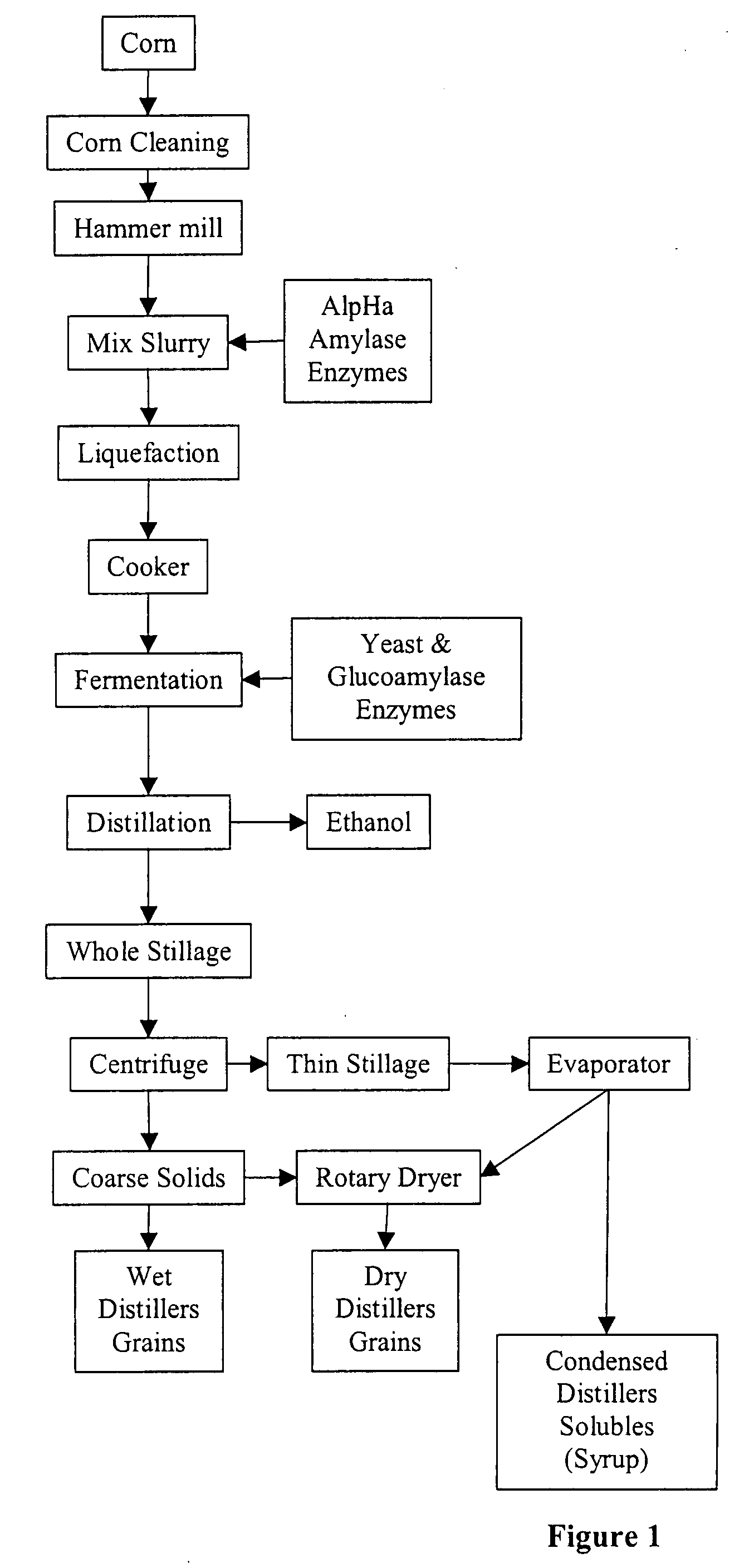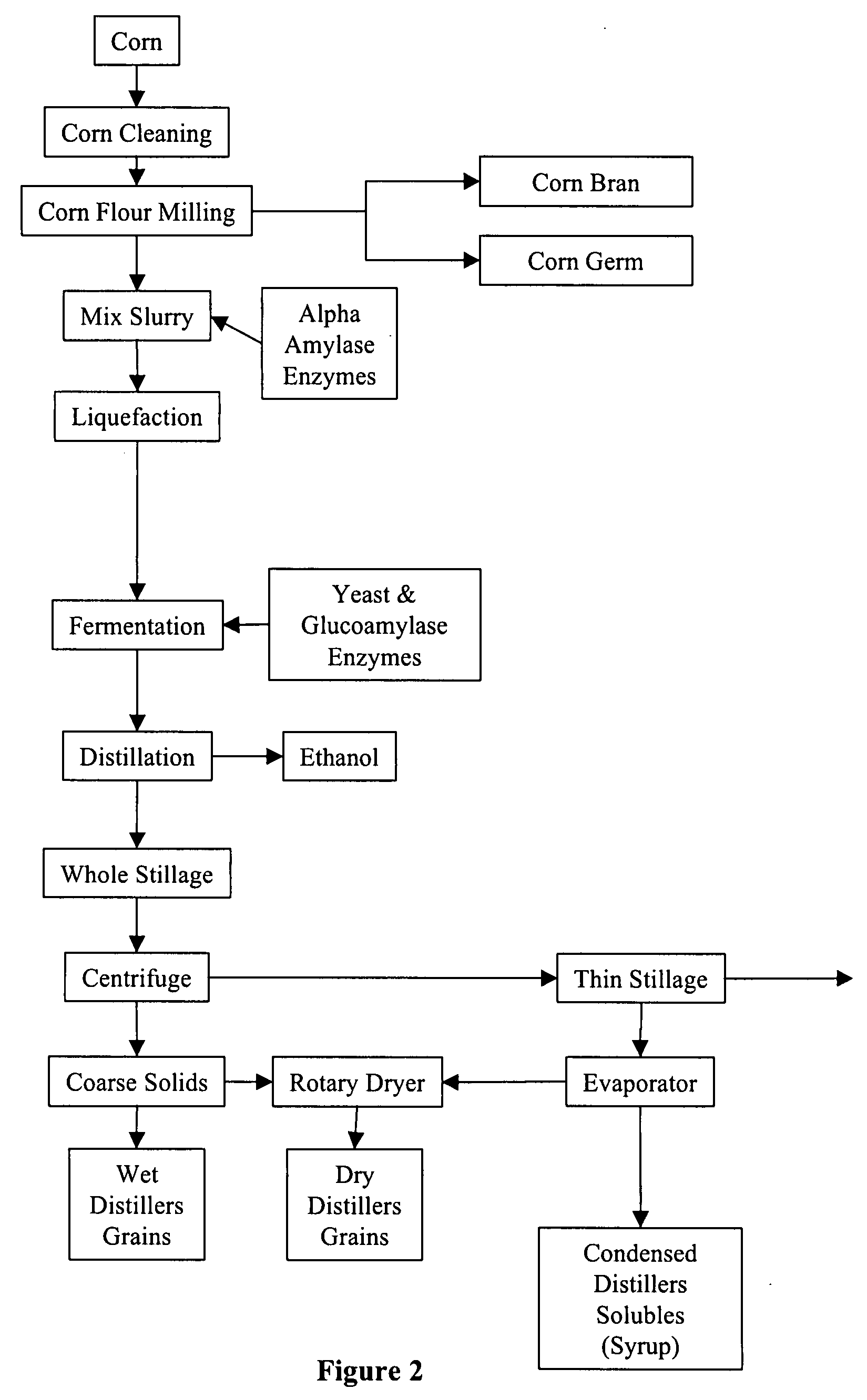Food products
a technology for food products and calf, applied in bakery products, food preparation, tea extraction, etc., can solve the problems of increasing the cost of ingredients, special challenges for calf, and economic hardship
- Summary
- Abstract
- Description
- Claims
- Application Information
AI Technical Summary
Benefits of technology
Problems solved by technology
Method used
Image
Examples
example 1
[0050] 11,500 grams of corn distillers solubles to which 1.15 grams each of BHA and BHT have been added are placed in a jacketed stainless steel container fitted with a cover to enable flooding the surface volume with nitrogen or carbon dioxide gas to prevent oxidation of the fats during processing. A high speed, high shear mixer is immersed in the CDS. The PH of the CDS is adjusted to PH 4.2 using 20 grams of NaOH dissolved in a 20% solution. The solution is mixed. An enzyme mixture consisting of cellulase, beta-glucanase, xylonase, mannanse, hemmicellulase, is added. These enzymes are provided by 4 grams Viscozyme, 2 grams Celluclast, 3 grams Shearzyme, 3 grams EDC Mannanase, 2 grams EDC Beta-glunanase. The enzymes are diluted in distilled water to 50 grams and added, while stirring, to the CDS. The heating jacket is activated and the high shear mixer is turned on. After 15 minutes an additional protease enzyme, trade named Flavourzyme, is added while stirring. After an additional...
example 2
[0051] 1,048.0 kilograms of corn distillers solubles are placed in a jacketed stainless steel container. A high speed, high shear mixer is immersed in the CDS. The heating jacket is activated and the high shear mixer is turned on. An enzyme mixture consisting of alpha galactosidase, cellulase, beta-glucanase, xylonase, mannanase, hemmicellulase, pectinase, and phytase is added. These enzymes are provided by 250 grams Viscozyme, 65 grams Celluclast, 72 grams Shearzyme, 12 grams EDC Mannanase, 15 grams Bio-Cat Beta-glucanase, 10 grams of Enzeco IIFG, 10 grams of Enzeco CEP and 10 gram of phytase. The enzymes are diluted in distilled water to 500 grams and added, while stirring, to the CDS.
[0052] The pH of the CDS solution is adjusted by passing the mixture through an ion exchange column containing 4 cubic feet of a weak anionic resin such as Rohm and Haas Amberlite FPA51. The solution is pumped at a rate of 3 gallons per minute to allow the resin to attach various minerals including ...
example 3
[0055] 11,500 grams of corn distillers solubles to which 1.15 grams each of BHA and BHT have been added are placed in a jacketed stainless steel container fitted with a cover to enable flooding the surface volume with nitrogen or carbon dioxide gas to prevent oxidation of the fats during processing. A high speed, high shear mixer is immersed in the CDS. The pH of the CDS is adjusted to pH 4.2 using 20 grams of NaOH dissolved in a 20% solution. The solution is mixed. An enzyme mixture consisting of cellulase, beta-glucanase, xylonase, mannanse, hemmicellulase, is added. These enzymes are provided by 4 grams Viscozyme, 2 grams Celluclast, 3 grams Shearzyme, 3 grams EDC Mannanase, 2 grams EDC Beta-glunanase. The enzymes are diluted in distilled water to 50 grams and added, while stirring, to the CDS. The heating jacket is activated and the high shear mixer is turned on. After 15 minutes an additional protease enzyme, trade named Flavourzyme, is added while stirring. After an additional...
PUM
 Login to View More
Login to View More Abstract
Description
Claims
Application Information
 Login to View More
Login to View More - R&D
- Intellectual Property
- Life Sciences
- Materials
- Tech Scout
- Unparalleled Data Quality
- Higher Quality Content
- 60% Fewer Hallucinations
Browse by: Latest US Patents, China's latest patents, Technical Efficacy Thesaurus, Application Domain, Technology Topic, Popular Technical Reports.
© 2025 PatSnap. All rights reserved.Legal|Privacy policy|Modern Slavery Act Transparency Statement|Sitemap|About US| Contact US: help@patsnap.com



